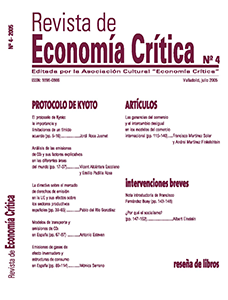Emisiones de gases de efecto invernadero y estructuras de consumo en España.
Palabras clave:
Input-output, Patrones de consumo, Emisiones gases efecto invernaderoResumen
La aplicación del principio contable de la producción y del consumo permite determinar la responsabilidad de la contaminación atmosférica desde dos perspectivas diferentes. En este artículo, sobre la base del principio contable del consumo, se analiza la relación entre los patrones de consumo de los hogares españoles y las emisiones de los gases de efecto invernadero en 1998. Para ello, se desarrolla un modelo input-output medioambiental ampliado en el que se combinan datos de tablas input-output, encuestas de presupuestos familiares y cuentas satélite sobre las emisiones atmosféricas. Finalmente, se muestra que, aunque los hogares con mayores ingresos son los que más contaminan en términos de unidades equivalentes de CO2, sus patrones de consumo, en cambio, contribuyen algo menos al efecto invernadero.
Descargas
Citas
BIESIOT, W. Y K. J. NOORMAN(1999): "Energy requirements of household consumption: a case study of The Netherlands", Ecological Economics, vol. 28, nº. 3, pp. 367-383. https://doi.org/10.1016/S0921-8009(98)00113-X
DE JUAN, O. Y E. FEBRERO(2000): "Measuring Productivity from Vertically Integrated Sectors", Economic Systems Research, vol. 12, nº. 1, pp. 65-88. https://doi.org/10.1080/095353100111281
DUCHIN, F. (1998): Structural Economics. Measuring Change in Technology, Lifestyles, and the Environment, Island Press, Washington D.C.
INE (1999): Encuesta Continua de Presupuestos Familiares. Base 97, Instituto Nacional de Estadística, Madrid.
INE (2003): "Tablas de origen y destino 1998", Cuentas económicas: Contabilidad nacional de España (base 1995). Marco input-output, disponibles en www.ine.es.
INE (2004): Estadísticas de Medio Ambiente. Cuentas Ambientales 2002, Instituto Nacional de Estadística, Madrid.
IPCC (1997): Revised 1996 IPCC Guidelines for National Greenhouse Gas Inventories, Intergovernmental Panel on Climate Change, Reino Unido.
JACOBSEN, H. K. (2000): "Energy demand, structural change and trade: a decomposition analysis of the Danish manufacturing industry", Economic Systems Research, vol. 12, nº. 3, pp. 319-343.
https://doi.org/10.1080/09535310050120916
LEZEN, M. (1998): "The energy and greenhouse gas cost of living for Australia during 1993-94", Energy, vol. 23, nº. 6, pp. 497-513. https://doi.org/10.1016/S0360-5442(98)00020-6
LEZEN, M. (2001): "A generalised input-output multiplier calculus for Australia", Economic Systems Research, vol. 13, nº. 1, pp. 65-92. https://doi.org/10.1080/09535310120026256
MANCERO, X. (2001): Escalas de equivalencia: reseña de conceptos y métodos, Serie Estudios Estadísticos y Prospectivos, CEPAL, Publicaciones de las Naciones Unidas, Santiago de Chile.
MILLER, R. E. Y P. D. BLAIR (1985): "Energy Input-Output Analysis" y "Environmental Input-Output Analysis", Input-Output Analysis: Foundations and Extensions, Prentice-Hall, Englewood Cliffs, cap. 6 y 7, pp. 200-265.
MINISTERIO DE MEDIO AMBIENTE (2003): Inventario de emisiones de gases de efecto invernadero de España. Años 1990-2002. Comunicación a la Comisión Europea, (Decisión 1999/296/CE), Subdirección General de Calidad Ambiental, Dirección General de Calidad y Evaluación Ambiental, Ministerio de Medio Ambiente, Madrid.
MORENO, M. C. (2004): Discriminación fiscal de la familia a través del IRPF. Incidencias de la diversidad territorial en la desigualdad del tratamiento, Documentos Instituto de Estudios Fiscales, Documento nº. 18/04.
MUKHOPADHYAY, K. Y D. CHAKRABORTY (1999): "India's energy consumption changes during 1973/74 to 1991/92", Economic Systems Research, vol. 11, nº. 4, pp. 423-438. https://doi.org/10.1080/09535319900000030
MUNKSGAARD, J. Y K. A. PEDERSEN(2001): "CO2 accounts for open economies: producer or consumer responsibility?", Energy Policy, nº. 29, pp. 327-334. https://doi.org/10.1016/S0301-4215(00)00120-8
MUNKSGAARD, J.; K. A. PEDERSEN Y M. WIER (2000): "Impact of household consumption on CO2 emissions", Energy Economics, nº. 22, pp. 423-440. https://doi.org/10.1016/S0140-9883(99)00033-X
PASINETTI, L. (1981): Structural Change and Economic Growth: a theoretical essay on the dynamics of the wealth of nations, Cambridge University Press, Cambridge, (tr. castellana de Manuel Ahijado, Cambio estructural y crecimiento económico, Ediciones Pirámide, Madrid, 1985).
PROOPS, J. L. R.; M. FABER Y G. WAGENHALS (1993): Reducing CO2 Emissions: A Comparative Input-Output Study for Germany and the UK, Springer, Berlin. https://doi.org/10.1007/978-3-642-77792-9
KURZ, H. D.; E. DIETZENBACHER Y C. LAGER (eds.) (1998): "Energy and Environment", Input-Output Analysis, Edward Elgar, Cheltenham, vol. II, pp. 3-128. https://doi.org/10.4337/9781843768678.00083
SCHNEIDER, M. H. Y S. A. ZENIOS (1990): "A comparative study of algorithms for matrix balancing", Operations Research, vol. 38, nº. 3, pp. 339-455. https://doi.org/10.1287/opre.38.3.439
UNITED NATIONS (1997): Kyoto Protocol to the United Nations Framework Convention on Climate Change, 10 December 1997 (FCCC/CP/L.7/Add.1) https://doi.org/10.1093/jel/10.1.215
VRINGER, K. Y K. BLOK (1995): "The direct and indirect energy requirements of households in the Netherlands", Energy Policy, vol. 23, nº. 10, pp. 893-910. https://doi.org/10.1016/0301-4215(95)00072-Q
WEBER, C. Y A. PERRELS (2000): "Modelling lifestyle effects on energy demand and related emissions", Energy Policy, nº. 28, pp. 549-566. https://doi.org/10.1016/S0301-4215(00)00040-9
WIER, M. (1998): "Sources of changes in emissions from energy: a structural decomposition analysis", Economic Systems Research, vol. 10, nº. 2, pp. 99-113. https://doi.org/10.1080/09535319808565469
WIER, M.; M. LEZEN; J. MUNKSGAARD Y S. SMED (2001): "Effects of Household Consumption Patterns on CO2 Requirements", Economic Systems Research, vol. 13, nº. 3, pp. 259-274.
https://doi.org/10.1080/09537320120070149
WILTING, H. C.; W. BIESITO Y H. C. MOLL (1999): "Analyzing potentials for reducing the energy requirement of households in The Netherlands", Economic Systems Research, vol. 11, nº. 3, pp. 233-243. https://doi.org/10.1080/09535319900000016
Descargas
Publicado
Cómo citar
Número
Sección
Licencia
Esta licencia permite a terceros compartir (copiar y redistribuir el material en cualquier medio o formato) y adaptar (remezclar, transformar y crear a partir del material para cualquier finalidad, incluso comercial), siempre que se reconozca la autoría y la primera publicación en esta revista (La Revista, DOI de la obra), se proporcione un enlace a la licencia y se indique si se han realizado cambios en la obra.







